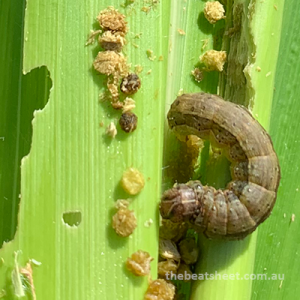
Medium larva and ‘shot hole’ damage
Fall armyworm (FAW, Spodoptera frugiperda) is an exotic pest that was first detected on the Australian mainland in February 2020. Eradication has been determined to be unfeasible and it is now classified as an endemic pest. Reported to have a very wide potential host range, it has so far shown a distinct preference for grass species with whorls, including sweet corn, maize and sorghum, where crop destruction can happen rapidly under high infestation levels. Resistance to carbamates (Group 1A), organophosphates (Group 1B) and pyrethroids (Group 3A) is common.
Learn more about this pest:
NEW (October 2024)
Listen to DPI’s Principal Entomologist Melina Miles in the new Dairy Industry podcast about FAW (November 2024)
The Beatsheet sends out updates on this pest as information becomes available. Type FAW into the search box to find FAW-related information on this site, including our blog posts.
Webinars and recent presentations
- Fall Armyworm | Identification tips and management options (GRDC video featuring Melina Miles, May 2024)
- Detecting and assessing fall armyworm (FAW) infestations in winter cereals and pasture (factsheet, May 2024)
- FAW update (focus on winter fodder and grain crops) Melina Miles, April 2024
- FAW management considerations and risk assessment (GRDC Online Update, February 2024)
- FAW in sorghum (seminar hosted by AgBitech; November 2021 – opens in YouTube). Presenters include Dr Melina Miles (DAF), Brock Welch, (AgBiTech US – Kansas), and Gustavo Shiomi and Murilo Moreira (AgBiTech Brazil)
- Subtropical dairy industry presentation on FAW in forage (includes segment by Melina Miles only; September 2021 – opens in YouTube)
- GRDC update webinar on FAW (March 2021). Includes recording and Update paper.
- GRDC update webinar on FAW (November 2020). Includes recording and Update paper.
- FAW for horticulture agronomists presentation (August 2020)
- An Invertebrate pest management in maize presentation (August 2020) includes planning for FAW.
See also our presentations page for more information and links to earlier recordings.
Other resources
Current research into FAW in horticulture by Queensland’s Department of Agriculture and Fisheries can be found at the DAF Engagement hub. DAF also has several pages on FAW on the Business Queensland website.
NSW DPI have recently added a pdf identification guide to their fall armyworm webpage.
The GRDC has a Fall armyworm: a crop invader on the march page with identification information and links to other resources.
A short video on FAW in sugarcane from Burdekin Productivity Services (opens in Facebook).
The Plant Biosecurity Research Initiative has published a fall armyworm continuity plan and a podcast series on FAW. It explores the experiences and observations of experts from around the globe and here in Australia. Visit the PHA website.
CropLife Australia has released a FAW resistance strategy.
A range of spray permits for fall armyworm are available. Search for permits relevant to your crop/situation at the APVMA website.
The DARABUG insect development model provides a convenient and readily available means of predicting development times using different insect models, including FAW. Gridded climatic data of daily temperatures is used to generate estimates of the dates of occurrence for each stage throughout the whole lifecycle of an insect. The science behind the modelling is described in Regional and seasonal activity predictions for fall armyworm in Australia (Insect Science volume 1).
Cesar Australia have developed a wind dispersal forcasting tool to help predict FAW movement.
DPIRD (Western Australia) has released a Fall armyworm surveillance manual with instructions for using pheromone traps.
CottonInfo has a short video highlighting some of the similar characteristics between caterpillars and an Endemics to exotics factsheet that looks at some of the differences between armyworm species found in the tropics.
